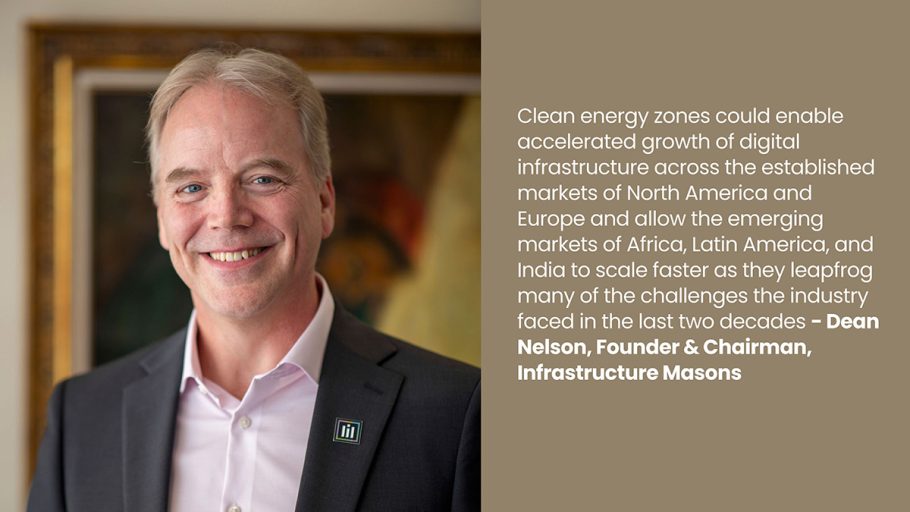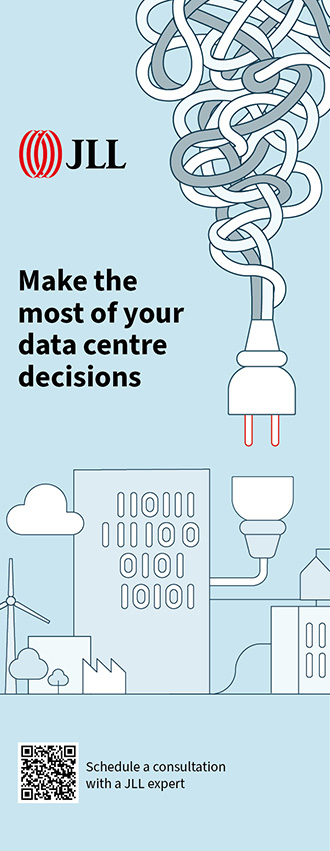As I highlighted at the start of this story, conversations during the development of the SOTI about the challenges around power, people, perception, and the planet surfaced a new vision for the digital infrastructure industry: clean energy zones. We defined clean energy zones as master-planned towns or city-size areas developed around concentrated sources of clean energy to serve multiple industries, including multi-tenant data center complexes.
In the report, we speculated that the size of these zones and corresponding energy generation will vary by each market’s current capacity and growth trends. In some markets, such as Africa and Latin America, these zones could be less than 100MW while others, such as the US, could exceed 10GW. Complementary power-intensive industries such as battery and green hydrogen production could colocate in these zones. Housing, schools, restaurants and retail in these zones would attract people with an opportunity to gain the skills necessary to work in and support the digital infrastructure and adjacent industries.
The zones could also support next generation building materials like carbon storing concrete that need funding and local, concentrated demand to scale economically. Similar scaling would be possible for next generation clean energy technologies, including sustainable storage, renewable fuels like hydrotreated vegetable oil (HVO) to replace diesel, small modular reactors, hydrogen fuel cells, enhanced geothermal, and fusion.
Clean energy zones could enable accelerated growth of digital infrastructure across the established markets of North America and Europe and allow the emerging markets of Africa, Latin America, and India to scale faster as they leapfrog many of the challenges the industry faced in the last two decades. Successful development of these zones will require coordination between the digital infrastructure industry and governments, power and water utilities, community leaders, adjacent industries, and anyone else who wants to see the digital economy grow in the digital age.
Since the vision of clean energy zones was laid out in the SOTI, iMasons have continued to discuss the clean energy zone concept and look for examples in the market today that could serve as a model. Among the examples we’ve identified include:
- Bulk Infrastructure’s N01 campus in Southern Norway is located next to the largest substation in Europe with direct and redundant connections to multiple hydroelectric power plants that provide 100 percent clean energy. The campus offers scalability across 740 acres (300-hectares), more than 1GW of renewable power capacity, and connectivity to three subsea and four terrestrial fiber optic cables with direct connections to the US and Europe.
- DataVolt executives built the largest green hydrogen production facility in the world. It turns excess wind and solar into 600 tons of green hydrogen a day in Saudi Arabia, which it plans to use to power data centers, desalination plants, and other industrial facilities as part of a master-planned industrial complex that aligns with the kingdom’s Vision 2030 national agenda.
- Quantum Loophole is building a master-planned data center campus on 2,100 acres in Frederick, Maryland. The project rejuvenates an industrial brownfield, repurposes existing transmission lines to supply MW power to clients, recycles greywater for cooling, and sets aside 600 acres of the campus for a nature reserve to capture carbon, provide a wildlife corridor, and create a visual buffer between nature and industry. The campus is surrounded by a 40-mile fiber ring that tunnels under the Potomac River and connects Frederick with Data Center Alley in Northern Virginia in one half millisecond round trip time (RTT).
The Bulk Infrastructure, DataVolt, and Quantum Loophole projects are also examples of another finding in the SOTI: We need to move data centers to the power instead of trying to force fit data centers into population centers and bring power to them. We know that power is constrained in saturated markets like Northern Virginia. Quantum Loophole leverages available power capacity in a market adjacent to Data Center Alley and built fiber connections to it. Similarly, Bulk Infrastructure leverages Norway’s abundant clean hydroelectric power and fiber connectivity to Europe and North America. These trends are the seeds of the clean energy zone vision—of master-planned communities that are in economic, social, and ecological balance. To sharpen this vision further, we are engaging with our members at meetings around the world to understand how the concept fits into their unique markets and regions. For example, I ran a session at the iMasons Member Summit during the Datacloud Global Congress in Cannes, France, this June where I asked our members to imagine the development of a clean energy zone in economic, social, and ecological balance with a community in Europe or the Middle East. See the call-out box to the right for highlights from that discussion.

The power demands of AI and machine learning are forcing a rethink of digital infrastructure development. Today, we do not have the power where we need it. If we move the data center to the power, what does that look like? That’s the opportunity before us. We can implement clean energy zones following the framework outlined in the Data Centers as a Good Neighbor guidebook and in alignment with the emerging Social Accord to achieve economic, social, and ecological balance within the local communities where digital infrastructure is deployed. If we come together on these initiatives, we will compound our impact and truly achieve a greater digital future for all. To get involved, please join us at iMasons.org
At the iMasons Member Summit during the Datacloud Global Congress in Cannes, France, table teams presented visions for clean energy zones that tapped clean energy in the Nordics, Portugal, and the Middle East and revitalized industrial economies in the United Kingdom and Poland. Some trends that emerged that continue to sharpen the clean energy zone vision include:
Clean energy innovation: Teams discussed several approaches to clean energy generation, including combinations of wind, solar, and storage. One team paired offshore wind with hydro-pumped storage, and another replaced coal plants in an abandoned industrial zone with SMRs as part of a broad community revitalization plan.
Waste heat reuse: Data centers generate a tremendous amount of waste heat. Several teams discussed options to capture and integrate this waste heat with district heating systems. Other teams proposed using waste heat to support greenhouse agriculture to provide local communities with fresh fruits and vegetables year-round.
Industrial revitalization: Master planning for clean energy zones can leverage existing infrastructure in economically depressed industrial zones, including substations, warehouses, and factories. These zones may also have under-utilized power generation and transmission capacity to support modern AI workloads.
Cooling water: Several teams discussed sourcing sea water for cooling applications. One team took this a step further, coupling it with a desalination plant to provide freshwater for the community and extract rare minerals from the brine.
Workforce retraining: Clean energy zones are reliable sources of employment. One team recommended tapping into the immigrant workforce to fill the labor gap and help alleviate pressures of immigration on communities. Other teams focused workforce retraining efforts on people from depressed industries like steel workers.
ABOUT THE AUTHOR
Dean Nelson is CEO of Cato Digital and the Founder & Chairman of Infrastructure Masons. His 35-year career includes leadership positions at Sun Microsystems, Allegro Networks, eBay, PayPal, and Uber. Dean has deployed 10 billion USD in digital infrastructure across four contents. Since its founding in 2016, iMasons has amassed a global membership representing over 200 billion USD in infrastructure projects spanning 130 countries.



